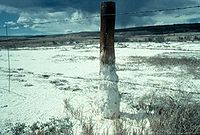
Photo from wikipedia
The agriculture in Biskra, southeastern Algeria, is based on traditional practices and characterized by small irrigated fields. In the last decades, the increasing demand in water as well as the… Click to show full abstract
The agriculture in Biskra, southeastern Algeria, is based on traditional practices and characterized by small irrigated fields. In the last decades, the increasing demand in water as well as the scarcity of rainfall has forced many farmers to use groundwater of low quality to maintain the profitability of their crops. Unfortunately, this practice seems to be the main harmful factor for soil quality in the region since it is responsible for the salinization of the irrigated areas. Aiming to assess the impact of this phenomenon, the soils of the irrigated perimeter of El Ghrous—a representative rural community located in the west of Biskra—have been analyzed. A set of 82 soil samples was collected from top and subsoil (0–15 and 15–35 cm respectively), on which the following physicochemical analyzes were performed: Ca 2+ , Mg 2+ , K + , Na + , Cl − , SO 4 2− , HCO 3 − , NO 3 − , pH, electrical conductivity (EC) and sodium adsorption ratio. A Principal Component Analysis was performed to individuate the geochemical processes that influenced significantly the evolution of soil salinity and its pathways. The results showed a calcium sulfate (CaSO 4 ) facies with a high risk of salinity and a low to medium risk of alkalinity. The calcite residual alkalinity and generalized residual alkalinity decreased as the solutions became more concentrated. Most of the samples were oversaturated in carbonate minerals (aragonite, calcite, and dolomite) and undersaturated in evaporitic minerals (anhydrite, gypsum, and halite). Finally, two multiple linear regressions (using cations and anions as independent variables) have been proposed to quantify soil salinity. These equations, with an accuracy of 85 %, can represent a time and money-saving tool for managers and farmers to estimate the EC, in comparison to the traditional estimation methods.
Journal Title: Acta Geochimica
Year Published: 2020
Link to full text (if available)
Share on Social Media: Sign Up to like & get
recommendations!